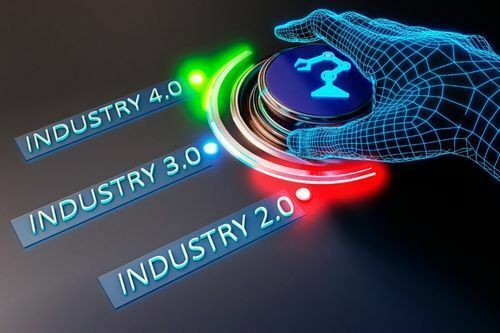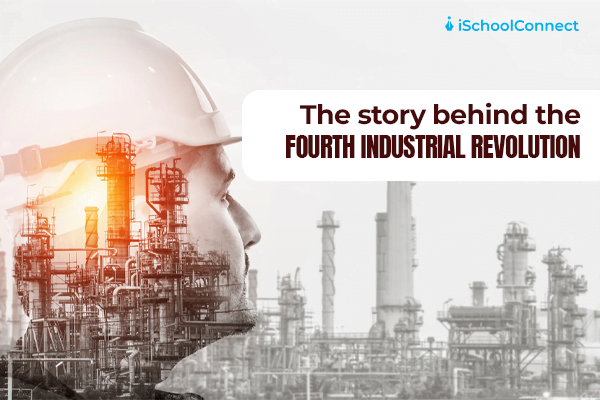Table of Contents
The human race has gone through several revolutions to reach where it is today. The first industrial revolution happened in the 18th century with steam engines. The second one began in the 1950s with computers and digitalization. Today we are going through the fourth industrial revolution. Some predict it will change our society for good, and some believe it can destroy it. Let’s look at the definition and components of this fourth industrial revolution to understand if it is a boon or bane for us.
What is the fourth industrial revolution?

The fourth industrial revolution is also known as the 4IR or Industries 4.0. This is the name of the current industrial advancements. It was first conceptualized in the year 2016.
Klaus Schwab, the founder and executive chairman of the World Economic Forum, first used the term fourth industrial revolution in one of the conferences. He predicted that this revolution would change our society. He said, “the changes are so profound that there has never been a time of greater promise or potential peril.”
The fourth industrial revolution would be defined as a revolution that blurs lines between the physical, digital, and biological worlds. The key components of this revolution are artificial intelligence(AI), robotics, gene editing, 3D printing, the internet of things(IoT), quantum compounding, etc.
The prominent examples of this industrial revolution include the Google map showing the fastest route to your destination, the artificial intelligence system of Siri and Alexa advancing in features, and your Instagram and Netflix recommendations that study your taste and show you the content you may like.
The components of the fourth industrial revolution
Technological advancements are pushing us to the future, where machines will take up most of our daily tasks. We won’t even need to push a button to command. The machine will be designed to think and comprehend what needs to be done. That’s just one of the things that this revolution brings.
Let’s see all the components one by one.
Artificial intelligence

AI or artificial intelligence systems are taking over the daily use of machinery. They are upgrading with each day. These AI technologies can now understand complex patterns, process information, draw conclusions, and make recommendations.
The use of artificial intelligence is more profound than we can even think of. They are not limited to recommending music or giving directions. They are now being advanced to perform surgery, spot patterns in unsaturated data, and drive cars.
Blockchain
The technology is used to share data without third-party intermediaries. It is a secure, decentralized, and transparent way of sharing data. It can be used to make traceable supply chains, secure sensitive medical data, combat voter fraud, etc.
One of the prominent examples of the blockchain is Bitcoin. It is a digital currency application that has captured the world’s attention.
Smarter computers
Computer technology is constantly advancing. They work towards making computers smarter, faster, and loaded with advanced features. Cloud computing made it easy to store vast amounts of data.
Quantum computing technologies are making computers more advanced. They are adding more and more features to extend the computer’s potential. This potential will be used to create highly complex data models in seconds and discover new materials.
Virtual and augmented reality
The augmented realities can appear the same but are different technologies. Virtual reality (VR) gives an immersive digital experience, while augmented reality (AR) merges the physical and digital worlds.
An example of VR would be video games. An example of AR can be the Lenskart application, which has a system to scan our faces and suggest lenses according to it.
Biotechnology
Scientists combine technology with biology in the biotechnology section. They harness cellular and biomolecular processes to develop new products in pharmaceuticals. They work on making the industrial manufacturing process of drugs more efficient.
The COVID-19 vaccines are a prominent example of the advancement in biotechnology.
Robotics

Scientists are trying to normalize using robots for personal and industrial purposes. They have started to use them on initial levels, but with more research, robots can and will assist humans in every way. The current robots are extremely complex and sophisticated. Scientists are trying to make them easy to handle.
In the future, they can be used for healthcare assistance, industrial advancement, safety guidance, and household assistance.
The Internet of Things(IoT)
It is a component that embeds the internet into everyday items. Products like smart watches or medical patches that monitor the user’s physical conditions are included in the IoT technologies. They are designed to collect customers’ data and use it to promote different products and services.
These can be used for industrial purposes as well. For example, agricultural equipment has IoT in them to monitor and keep track of the crops.
3D printing
This can prove to help a lot in manufacturing units. 3D printing technology can print their parts with fewer tools, faster speed, and lower costs.
Key takeaways
- The fourth industrial revolution is considered to bring efficiency and productivity into industries.
- One of the cons of this revolution is that it will discriminate jobs into low-skill/low-pay and high-skills/high-pay systems.
- We can’t predict definitely if it will be a boon or bane for us, but one thing is for sure, we can’t stop it from expanding. The fourth industrial revolution will bring everything we have wished for in technology.
We hope you find this article helpful. Write to us your comments. Click here to read more such articles.
Liked this blog? Read next: Robotics Engineering | 5 best colleges to pursue this course!
FAQs
Q1. What caused the fourth industrial revolution?
Answer: The conversion of digital, biological, and physical advancements caused the fourth industrial revolution.
Q2. What are the pros of the fourth industrial revolution?
Answer: The main pros of the fourth industrial revolution are higher productivity, improved quality of life, new markets, and low barriers to startup industries.
Q3. What are the cons of the fourth industrial revolution?
Answer- The 4 main cons of the fourth industrial revolution are inequality in jobs, cybersecurity risks, core industries disruption, and ethical issues.






